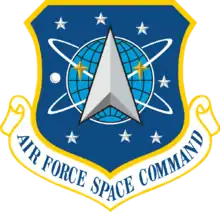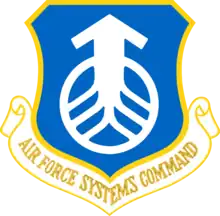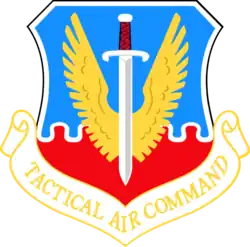This is a list of major commands (MAJCOM) of the United States Air Force.
A major command is a significant Air Force organization subordinate to Headquarters, US Air Force. Major commands have a headquarters staff and subordinate organizations, typically formed in numbered air forces, centers, wings, and groups.[1]
Historically, a MAJCOM is the highest level of command, only below Headquarters Air Force (HAF), and directly above numbered air forces (NAFs).
The USAF is organized on a functional basis in the United States and a geographical basis overseas. A major command (MAJCOM) represents a major Air Force subdivision having a specific portion of the Air Force mission. Each MAJCOM is directly subordinate to Headquarters, Air Force. MAJCOMs are interrelated and complementary, providing offensive, defensive, and support elements. An operational command consists (in whole or in part) of strategic, tactical, or defense forces; or of flying forces that directly support such forces. A support command may provide supplies, weapon systems, support systems, operational support equipment, combat material, maintenance, surface transportation, education and training, or special services and other supported organizations.
From 1948 to 1991 MAJCOMs had the authority to form wings using manpower authorizations under their control. Each MAJCOM or other organization reporting directly to USAF was assigned a block of four digit numbers to use for units it organized. The system terminated in 1991 when USAF assumed control of all units except for provisional ones. While the majority of MAJCOM wings were support units, combat commands could (and did) create combat units on their own as shown at List of MAJCOM wings of the United States Air Force.
The USAF's last major reorganization of commands was in 1992. In July 2006, the Air Force Network Operations (AFNETOPS) command was stood up at Barksdale Air Force Base. At the time, it was anticipated that it would be transformed into a new MAJCOM: the Air Force Cyber Command.[2] However, this did not occur, and AFNETOPS was integrated into Air Force Space Command.
On 20 December 2019, the United States Space Force became an independent military service and Air Force Space Command was transferred and redesignated as Space Operations Command.
Since its inception in 1947, a total of 27 organizations have been designated as major commands. Over time, the role of MAJCOMs have changed: some were replaced with NAFs, while some NAFs were replaced with MAJCOMs.
Currently, the USAF is organized into nine MAJCOMS (seven functional and two geographic), with the Air National Guard component reporting to Headquarters, United States Air Force (HAF).[3] The most recent major command, Air Force Global Strike Command, was activated in August 2009. The other MAJCOMs have either inactivated or lost their command status.
Current
| Shield | Major Command | Headquarters | Current Commander | Mission |
|---|---|---|---|---|
 | Air Combat Command (ACC) | Langley AFB, Joint Base Langley-Eustis, Virginia, U.S. | Gen Mark D. Kelly | To support the global implementation of national security strategy, ACC operates fighter, reconnaissance, battle-management, and electronic-combat aircraft |
 | Air Education and Training Command (AETC) | Randolph AFB, Joint Base San Antonio, Texas, U.S. | Lt Gen Brian S. Robinson | Recruits, trains, and educates airmen |
 | Air Force Global Strike Command (AFGSC) | Barksdale AFB, Louisiana, U.S. | Gen Thomas A. Bussiere | Develop and provide combat-ready forces for nuclear deterrence and global strike operations |
 | Air Force Materiel Command (AFMC) | Wright-Patterson AFB, Ohio, U.S. | Gen Duke Z. Richardson | Conducts research, development, testing and evaluation, and provides the acquisition management services and logistics support necessary to keep Air Force weapon systems ready for war |
 | Air Force Reserve Command (AFRC) | Robins AFB, Georgia, U.S. | Lt Gen John P. Healy | Provides operational capability, strategic depth, and surge capacity as an integrated total force partner in every Air Force core mission |
 | Air Force Special Operations Command (AFSOC) | Hurlburt Field, Florida, U.S. | Lt Gen Tony D. Bauernfeind | Provide Air Force component units for United States Special Operations Command |
 | Air Mobility Command (AMC) | Scott AFB, Illinois, U.S. | Gen Michael A. Minihan | Provide global air mobility through airlift and aerial refueling for all of the United States Armed Forces. Air Force component of United States Transportation Command |
 | Pacific Air Forces (PACAF) | Hickam AFB, Joint Base Pearl Harbor Hickam, Hawaii, U.S. | Gen Kenneth S. Wilsbach | Provide Air Force component units for United States Indo-Pacific Command |
 .png.webp) | United States Air Forces in Europe – Air Forces Africa (USAFE-AFAFRICA) | Ramstein Air Base, Germany | Gen James B. Hecker | Provide Air Force component units for United States European Command and United States Africa Command |
Historic
| Shield | MAJCOM | Dates Active |
|---|---|---|
 | Alaskan Air Command | 1945–1990 |
 | Aerospace Defense Command | 1946–1950; 1951–1980 |
.png.webp) | Air Force Cyber Command (Provisional) | 2007–2008 |
 | Air Force Communications Command | 1961–1991[4] |
 | Air Force Intelligence Command | 1948–1993 |
 | Air Force Logistics Command | 1944–1992 |
 | Air Force Space Command | 1982–2019 |
 | Air Force Systems Command | 1950–1992 |
 | Air Proving Ground Command | 1946–1957 as major command |
 | Air Training Command | 1946–1993 |
 | Air University | 1920–1993 |
| Bolling Field Command | 1946-1958 | |
 | Caribbean Air Command | 1940–1976 |
 | Continental Air Command | 1948–1968 |
 | Electronic Security Command | 1948–1993 |
 | Headquarters Command, USAF | 1946–1976 |
 | Military Airlift Command | 1966–1992 |
 | Northeast Air Command | 1950–1957 |
 | Pacific Air Command | 1946–1949 |
 | Special Weapons Command | 1949–1952 |
 | Strategic Air Command | 1946–1992 |
 | Tactical Air Command | 1946–1992 |
 | United States Air Forces Southern Command | 1940–1976 |
References
- Donald, David, (Ed.) (1992). US Air Force Air Power Directory. Westport, CT: AIRtime Publishing Inc.
- ↑ Air Force Instruction 38-101, AIR FORCE ORGANIZATION, 4 APRIL 2006 (with Change 2, dated 20 July 2006), paragraph 2.2.2., page 10.
- ↑ Lopez, Staff Sgt. C. Todd (2006-11-03). "8th Air Force to become new cyber command". Air Force Print News. United States Air Force. Retrieved 2006-11-24.
- ↑ Pampe, Capt. Carla (2006-07-10). "Air Force officials consolidate network ops". Eighth Air Force Public Affairs. United States Air Force. Retrieved 2006-07-10.
- ↑ "Air Force Communications Command". af.mil. Retrieved 27 March 2018.
External links
 Media related to United States Air Force#Major Commands at Wikimedia Commons
Media related to United States Air Force#Major Commands at Wikimedia Commons


